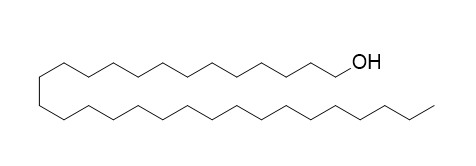1-Triacontanol
1-Triacontanol is a naturally occurring plant growth regulator. 1-Triacontanol is a saturated long-chain alcohol that has growth-promoting activities on a number of plants. 1-Triacontanol reduces reactive oxidative damage.
Inquire / Order:
manager@chemfaces.com
Technical Inquiries:
service@chemfaces.com
Tel:
+86-27-84237783
Fax:
+86-27-84254680
Address:
1 Building, No. 83, CheCheng Rd., Wuhan Economic and Technological Development Zone, Wuhan, Hubei 430056, PRC
Providing storage is as stated on the product vial and the vial is kept tightly sealed, the product can be stored for up to
24 months(2-8C).
Wherever possible, you should prepare and use solutions on the same day. However, if you need to make up stock solutions in advance, we recommend that you store the solution as aliquots in tightly sealed vials at -20C. Generally, these will be useable for up to two weeks. Before use, and prior to opening the vial we recommend that you allow your product to equilibrate to room temperature for at least 1 hour.
Need more advice on solubility, usage and handling? Please email to: service@chemfaces.com
The packaging of the product may have turned upside down during transportation, resulting in the natural compounds adhering to the neck or cap of the vial. take the vial out of its packaging and gently shake to let the compounds fall to the bottom of the vial. for liquid products, centrifuge at 200-500 RPM to gather the liquid at the bottom of the vial. try to avoid loss or contamination during handling.
Purinergic Signal.2024, doi: 10.1007.
Molecules.2023, 28(5):2376.
Molecules.2018, 23(9):E2121
Agriculture2024, 14(12), 2301
Plant J.2021, 107(6):1711-1723.
Anal Bioanal Chem.2018, 410(5):1561-1569
SSRN2024, 4937625.
J Biochem Mol Toxicol.2022, e23211.
Molecules.2019, 24(4):E709
Plants (Basel).2021, 10(11):2317.
Related and Featured Products
Xenobiotica . 2015 Jan;45(1):71-78.
Investigation on pharmacokinetics, tissue distribution and excretion of 1-triacontanol in rats by gas chromatography-tandem mass spectrometry (GC-MS/MS)[Pubmed:
25080280]
1. 1-Triacontanol (TA) recently shows promising anti-tumor activity. The present study was aimed to develop a sensitive gas chromatography-tandem mass spectrometry method to explore the pharmacokinetic profiles, distribution and excretion of TA in Sprague-Dawley rats after oral administration of TA. Chromatography separation was performed on a HP-5MS column. 1-Octacosanal was used as the internal standard (IS). Quantification of TA and IS was carried out at m/z 495.6 → 97.0 and m/z 467.5 → 97.0, respectively, in positive electron ionization and multiple reaction monitoring mode. The pharmacokinetic parameters were calculated by non-compartmental analysis. 2. The area under concentration-time curve AUC0-6 h and AUC0-∞ for TA at 60 mg/kg were 87.737 ± 13.574 and 93.617 ± 17.62, respectively. The mean residence time was 3.25 ± 0.17 h. In addition, the elimination half-lives (t1/2) were (2.37 ± 1.23, 1.27 ± 0.49, 2.07 ± 0.93) h after single oral administration of 30, 60 and 120 mg/kg of TA. After oral administration, TA was extensively distributed in stomach and intestine. The majority of TA excreted via feces, and its accumulative excretion ratio during the period of 72 h was 26.68 ± 7.14%, but only 0.0023 ± 0.0015% and 0.0027 ± 0.0006% for urines and bile, respectively. The absolute bioavailability (F, %) of TA was about 2.0%.
J Ethnopharmacol . 2015 Aug 22;172:80-84.
1-Triacontanol cerotate; isolated from Marsilea quadrifolia Linn. ameliorates reactive oxidative damage in the frontal cortex and hippocampus of chronic epileptic rats[Pubmed:
26117530]
Ethnopharmacological relevance: Marsilea quadrifolia Linn. (MQ) has been used for insomnia and epileptic disorders in traditional Indian medicine. The present study is to isolate the active component responsible for antiepileptic property of MQ by evaluating its ability to minimize the reactive oxidative damage in brain due to chronic epilepsy in rat.
Materials and methods: 1-Triacontanol cerotate (1TAC) was isolated after chromatography on a silica gel from dried petroleum ether fraction of methanolic extract of MQ. Acute oral toxicity studies of 1TAC were carried out and efficacy of 1TAC on malondialdehyde (MDA) and reduced glutathione (GSH) production in different brain areas of chronic pentylenetetrazole (PTZ) induced epileptic rats were evaluated.
Results: Our results showed that PTZ-kindled chronic epileptic rats had an increase MDA and decreased GSH concentration in the frontal cortex as well as hippocampus, compared to the normal control. MDA and GSH concentrations in those brain areas were normalized after treatment with sodium valproate (SV) in 200 mg kg(-1)bw; as well as 1TAC in 40 and 80 mg kg(-1)bw doses.
Conclusion: Production of reactive oxygen species (ROS) is known to worsen epileptogenesis. The isolated component 1TAC which reduced the reactive oxidative damage in hippocampus and frontal cortex of PTZ kindled rats could be responsible for antiepileptic property of MQ. Its action is found to be dose dependent, with 80 mg kg(-1)bw showing even better efficacy than 200 mg kg(-1)bw of SV.



